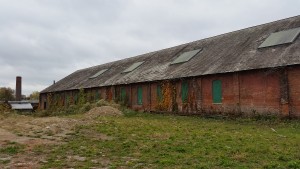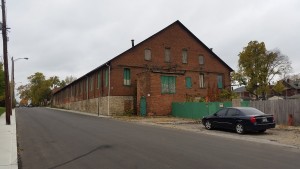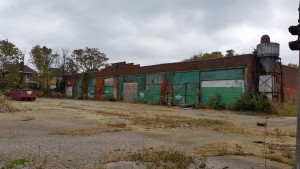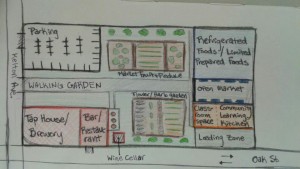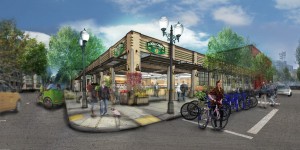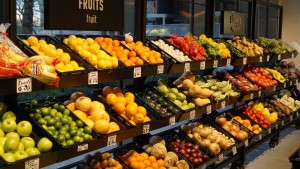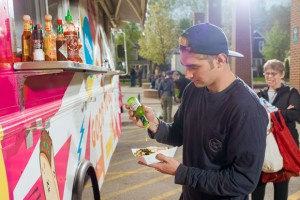The current site is located on the East Side of Columbus, near the Franklin Park Conservatory and Bexley, OH. The site is accessible through Oak Street and Kelton Avenue. There are three brick buildings on the site in various states of disrepair, the foliage on site is overgrown, and there is litter in and around the area. The Trolley Barn Block Watch set up with the 12th Precinct of Columbus police covers the neighborhood surrounding Franklin Park, lowering crime levels in and around the site.
Our group has the vision of creating a space that will not only stimulate the economy of the area, but work towards building a vibrant and cohesive community. We imagine spaces that will narrow divides and provide a forum for unity. Planned Neighborhood aims to develop a local produce hub along with a community-learning center. In addition our plan is to include a local brewery and tap house that will provide the nearby residents with a relaxing get away from their normal hustle and bustle. This development will be named The Trolley Barn Block.
The Westernmost side of the site will house our Barn Brewery and parking area.
The more centralized region of the site will be the home of our community gardens, where local gardeners can purchase a small plot to grow crops, herbs, and flowers. Located in the middle of the site, this area should get moderate sunlight in the middle of the day and shade in the dusk/dawn periods. Provided the soil is thoroughly tested, this area could support carrots, radishes, beets, broccoli, cauliflower, and leafy vegetables, some of which, including carrots and radishes, grow into the winter months, allowing for sustainable returns of produce. Considering the size of the site, yields would be modest, supporting the small market on a weekly, or every-other-week basis.
Located on the easternmost region of the site will be the proposed Trolley Car Market, Community Center, Learning Kitchen, and a loading dock to support deliveries to the market. The Learning Kitchen will act as an instructional site where families can learn about healthy eating options and how to prepare fresh meals. The Community Center is intended to be used as a space for family gatherings, community events, etc. to support healthy attitudes towards food and to promote the benefits of supporting local growers.
The re-purposed brownfield site will be accessible through many modes of transportation, but geared mainly towards those who use non-motorized transportation and public transit. Our consumers will be able to travel to the site on bus, by bike, driving, or with a quick walk. There will be parking amenities for both for bikes and cars, as well as street parking available in the case of lot overflow.
We imagine that although many neighbors will greatly favor our proposal, there will be skeptics. One concern could be that because this site is a brownfield, chemicals and toxins could have infiltrated the ground making it unsafe to grow healthy crops. We have a plan to clean the area of toxins through soil treatments, growth of plants that will revitalize the plots, transporting non-toxic dirt to the site, and the use of compost to create a healthy soil for our families. The compost will be provided from the market and brewery leftovers. Another concern might be that our site will bring in traffic and increase pedestrian visits in what is a relatively calm neighborhood. Although we do hope to bring traffic to the area, our plan is to create a serene space that one can visit to relax, run errands, or learn. In addition, we have taken measures that will act as a buffer to minimize noise from inside the development such as lining the site borders with trees and shrubbery. Finally, we understand that the brewery could have negative connotations associated with it. Our vision for the brewery is to have a tap house/restaurant location that would offer an inviting and relaxed atmosphere. This would be a family restaurant and have a separate brew room were customers could indulge in a few beverages. The establishment would have normal business hours, closing at ten on weekdays and midnight on the weekends, to respect the neighbors and reduce commotion and noise. This facet of the proposal would, of course, first have to gain public support at a neighborhood meeting, but we feel we could provide enough benefits to prove the Barn Bar an asset to the site and the neighborhood.
Overall, we know that the Trolley Barn Block will pay tribute to its roots but add a modern twist to the present neighborhood. We want our guests to be able to see landmarks such as the trolley barn and know that was the same trolley barn that their grandparents passed walking home from church each Sunday. In addition, we want to create a space that will one day be a lasting asset for the community and be a new piece of history for the site.



